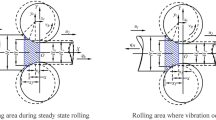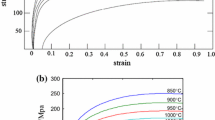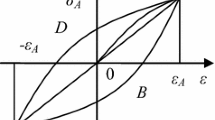Abstract
A vibration monitoring method of strip rolling mill based on the digital twin model was proposed which could effectively reduce the structure complexity and test cost of the traditional monitoring system. Firstly, the coupling vibration mechanism model of the dynamic characteristics of roll system and bearings of four-high mill was established. Secondly, the digital twin model of strip rolling mill vibration was built based on the mechanism model. At the same time, the traditional monitoring test of the rolling mill was carried out to verify the accuracy of the digital twin model. Through analyzing the experimental results, it could be found that the roll system is vibrating intensely with the increase of rolling force obvious fluctuation. Finally, based on the above research results, the corresponding measures were put forward to suppress the rolling mill vibration. In conclusion, the rolling mill vibration monitoring theory based on the digital twin model provided the technical support and theoretical basis for improving equipment operation stability and reducing testing costs.


























Similar content being viewed by others
References
Lin CW, Lin YK, Chu CH (2013) Dynamic models and design of spindle-bearing systems of machine tools: a review. Int J Precis Eng Manuf 14(3):513–521. https://doi.org/10.1007/s12541-013-0070-6
Wang D, Xiang W, Zhu H (2014) Damage identification in beam type structures based on statistical moment using a two step method. J Sound Vib 333(3):745–760. https://doi.org/10.1016/j.jsv.2013.10.007
Hu PH, Ehmann KF (2001) Fifth octave mode chatter in rolling. Proc Inst Mech Eng B J Eng Manuf 215(6):797–809. https://doi.org/10.1243/0954405011518737
Rothera A, Jelali M, Soffker D (2015) A brief review and a first application of time-frequency-based analysis methods for monitoring of strip rolling mills. J Process Control 35:65–79. https://doi.org/10.1016/j.jprocont.2015.08.010
Heidari A, Forouzan MR (1992) Optimization of cold rolling process parameters in order to increasing rolling speed limited by chatter vibrations. J Adv Res 4(1). https://doi.org/10.1016/j.jare.2011.12.001
Sun J, Peng Y, Liu H (2013) Coupled dynamic modeling of rolls model and metal model for four high mill based on strip crown control. Chin J Mech Eng 26(001):144–150. https://doi.org/10.3901/CJME.2013.01.144
Younes MA, Shahtout M, Damir MN (2006) A parameters design approach to improve product quality and equipment performance in hot rolling. J Mater Process Technol 171(1):83–92. https://doi.org/10.1016/j.jmatprotec.2005.06.052
Malik AS, Grandhi RV (2008) A computational method to predict strip profile in rolling mills. J Mater Process Technol 206(1–3):263–274. https://doi.org/10.1016/j.jmatprotec.2007.12.026
Farley T (2006) Rolling mill vibration and its impact on productivity and product quality. Light Metal Age 64(6):12–14
Singh GK, Kazzaz S (2003) Induction machine drive condition monitoring and diagnostic research—a survey. Electr Power Syst Res 64(2):145–158. https://doi.org/10.1016/S0378-7796(02)00172-4
Garcia MC, Sanz-Bobi MA, Pico JD (2006) SIMAP: Intelligent System for Predictive Maintenance: application to the health condition monitoring of a wind turbine gearbox. Comput Ind 57(6):552–568. https://doi.org/10.1016/j.compind.2006.02.011
Miao Z, Zou Z, Gao Z, Li N, Liu C (2016) Health monitoring and diagnosis system for heavy roll grinding machine. Adv Mech Eng 8(5). https://doi.org/10.1177/1687814016650419
Yang X, Luo H, Krueger M, Ding SX, Peng K (2016) Online monitoring system design for roll eccentricity in rolling mills. IEEE Trans Industr Electron 63(4):2559–2568. https://doi.org/10.1109/tie.2015.2442223
Sanfilippo F, Musella E, Biase N D, Petrelli A (2001) An advanced internet based data reporting system for on line monitoring of a hot rolling mill. In: Conferenza Associazione Italiana Metallurgia, Proceedings of the 7. Italy, pp 1–8
Zhao JH (1998) Analysis of the development of high-speed wire rod rolling technology at home and abroad. Steel Rollinng 7(4):47–51
Huang SG (2007) Troubleshooting of high wire finishing unit equipment. Plant Maintenance Engineering 4(3):46–49
Zhang JY, Gao LX, Wang HG, Yang JX (2005) The application of fault diagnosis technology in mill maintenance. Steel Rollinng 9(2):44–46
Huang ZJ (2017) Mechanical equipment vibration fault monitoring and diagnosis. Chemical Industry Press, Beijing
Zhu YC (2016) Vibration monitoring and fault diagnosis of high-speed wire rod finishing mill. Dissertation, Anhui University of Technology
Negri E, Fumagalli L, Macchi M (2017) A review of the roles of digital twin in CPS-based production systems. Procedia Manufacturing 11:939–948. https://doi.org/10.1016/j.promfg.2017.07.198
Tao F, Cheng J, Qi Q, Zhang M, Zhang H, Sui F (2017) Digital twin-driven product design, manufacturing and service with big data. Int J Adv Manuf Technol 94(9–12):3563–3576. https://doi.org/10.1007/s00170-017-0233-1
Tao F, Zhang H, Liu A, Nee AYC (2019) Digital twin in industry: state-of-the-art. IEEE Trans Industr Inf 15(4):2405–2415. https://doi.org/10.1109/tii.2018.2873186
Grieves MW (2005) Product lifecycle management: the new paradigm for enterprises. Int J Prod Dev 2(1/2):71. https://doi.org/10.1504/IJPD.2005.006669
Tuegel EJ, Ingraffea AR, Eason TG, Spottswood SM (2011) Reengineering aircraft structural life prediction using a digital twin. Int J Aerosp Eng 2011:1–14. https://doi.org/10.1155/2011/154798
Tao F, Qi Q (2019) New IT driven service-oriented smart manufacturing: framework and characteristics. IEEE Transactions on Systems, Man, and Cybernetics: Systems 49(1):81–91. https://doi.org/10.1109/tsmc.2017.2723764
Tao F, Qi Q (2019) Make more digital twins. Nature 573(7775):490–491. https://doi.org/10.1038/d41586-019-02849-1
Zhuang C, Liu J, Xiong H (2018) Digital twin-based smart production management and control framework for the complex product assembly shop-floor. Int J Adv Manuf Technol. https://doi.org/10.1007/s00170-018-1617-6
Afazov S, Scrimieri D (2020) Chatter model for enabling a digital twin in machining. Int J Adv Manuf Technol 110(9–10):2439–2444. https://doi.org/10.1007/s00170-020-06028-9
Zhang Y (2016) Dynamics modeling of plate and strip mill system based on the rigid-flexible coupling characteristics of the roll system. Dissertation, Yanshan University
Liu GM, Cheng X (2016) Bearing load distribution and roll system elastic deformation in a four-roller mill. Journal of Plasticity Engineering 23(01):73–78
Funding
The authors are grateful for the supports of the National Natural Science Foundation of China (Grant No. 51905365), the Grant from Shanxi Major Science and Technology Projects (No. 20181102015), and the National Key R&D Program of China (No. 2018YFA0707305).
Author information
Authors and Affiliations
Contributions
All authors contributed to the study conception and design. Material preparation, data collection, and analysis were performed by Yang Zhang; digital twin modeling by Weizhong Wang; finite element analysis by Han Zhang and Haichao Li; and material curation by Cuirong Liu and Xiaozhong Du to proceed and all authors commented on previous versions of the manuscript. All authors read and approved the final manuscript.
Corresponding author
Ethics declarations
Competing interests
The authors declare no competing interests.
Additional information
Publisher's Note
Springer Nature remains neutral with regard to jurisdictional claims in published maps and institutional affiliations.
Rights and permissions
Springer Nature or its licensor holds exclusive rights to this article under a publishing agreement with the author(s) or other rightsholder(s); author self-archiving of the accepted manuscript version of this article is solely governed by the terms of such publishing agreement and applicable law.
About this article
Cite this article
Zhang, Y., Wang, W., Zhang, H. et al. Vibration monitoring and analysis of strip rolling mill based on the digital twin model. Int J Adv Manuf Technol 122, 3667–3681 (2022). https://doi.org/10.1007/s00170-022-10098-2
Received:
Accepted:
Published:
Issue Date:
DOI: https://doi.org/10.1007/s00170-022-10098-2




